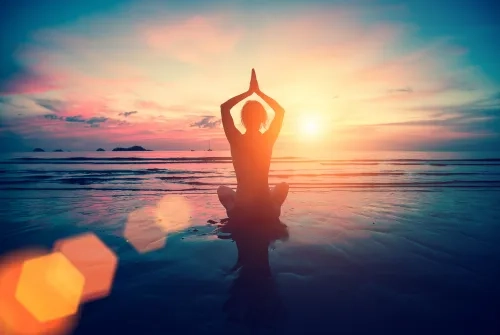Alo Yeditepe
Alo Yeditepe
The Way to Peace: Yoga
Today, where cancers and autoimmune diseases are rapidly increasing, it is seen that modern medicine is insufficient in the treatments for the cause of these diseases. Despite advances in oncology and autoimmunity, treatments are often aimed at suppressing signs and symptoms. Many chemotherapy drugs in the field of cancer can be used limited due to their intense side effects. Again, since radiotherapy approaches also damage normal tissues, they are subject to various restrictions. In autoimmune diseases, the patient's immune system is usually tried to be suppressed with cortisone or other immunosuppressive drugs, and the attacks of the disease can be prevented or stopped in this way. In summary, modern medicine is inadequate in terms of causal treatments.
In both cancer and autoimmune diseases, there are many internal factors as well as external factors in the cause of the disease. Although the genetic structure of the body is at the beginning of the internal factors, the person's immune system also plays a very important role. External factors that already constitute the disease are various chemical and biological causes that disrupt the functioning of the immune system, which acts as the body's defense system, such as the consumption of dirty air, dirty water, and dirty food in the simplest examples. Therefore, despite all these medical advances today, instead of getting sick and receiving treatment, "how not to be sick?", "how should we protect our health?" thinking and acting in this way will be more beneficial for both the individual and the society.
Since the subject of this article is Yoga, as one of the ways to protect our health without getting sick, we want to leave aside other complementary and protective methods and examine Yoga, which approaches the body, mind, and spirit trinity as a whole.
History of Yoga
Yoga is an ancient Indian teaching known to date back to 2000 BC. Most people can perceive yoga as a form of exercise. In fact, with the fitness that yoga movements bring to the body, it is said that "one tries to reach mental comfort and spiritual peace." In the spiritual dimension, yoga is the path to a higher level of consciousness beyond the sensory perceptions and knowledge we perceive in the material dimension. It is a guide for a person to be physically, mentally, and spiritually good. The sacred texts on this subject date back to before the millennium. This is called “Farewell.” In the 900s BC, the Yoga Sutras of the yoga sage Patanjali are among the best known. It consists of 196 short concise words. In these sutras, Patanjali defines yoga as a practice for the control of the mind.
It is said that yoga practices are actually done to prepare the body to sit for a long time in a “meditation (mind control)” pose.
What is Meditation and Why is it Done?
Especially in recent years, it is an application that has entered the agenda of the Western world as "mindfulness", which we can translate as "mental awareness", and it is recommended to do it in order to live a healthy and successful life. The Eastern world has been practicing and recommending it for centuries.
In meditation, a comfortable cross is usually established, hands are placed on the knees, the spine is made upright, and the sitting is motionless with the eyes closed by breathing comfortably. The mind is focused on one thing. This can be in the form of breathing, following the breath by counting, or repeating a certain word or a few words, which is also called a mantra. When the mind focuses on a certain thing, it gradually begins to move away from the thoughts of daily and material life. The purpose of meditation is to strive to reach the essence by moving mentally away from this material-physical dimension and moving to a deeper and higher dimension.
This is not an easy task and requires a lot of practice. During meditation, no matter how focused the mind is, it necessarily escapes or becomes trapped in cheeky thoughts, forgetting to focus. In principle, when this is realized, it is necessary to free the mind from these thoughts or to evade them and invite it to focus again on a certain object.
Usually, 20–60-minute meditations are recommended. In order to sit in this way without moving, the body must be ready, especially the joints and muscles. For this reason, yoga movements and poses have been used for centuries to prepare for meditation. But whether or not every yoga practitioner meditates today is also a question mark.
Yoga is Not Only for the Body But Also for the Soul
Today, yoga can also be applied as an option to sports such as aerobics and pilates in gyms. However, it is his spiritual approach that distinguishes yoga from other sports. In other words, it does not only appeal to the body, but also to the mind and spirit. Yoga sages define man as a whole of the trinity of body, mind, and spirit. Therefore, it is a basic goal to purify the mind and soul, to bring peace and tranquility based on yoga movements. Don't we have a nice phrase to remind us of that? "A healthy mind in a healthy body"
When it comes to yoga movements, many people may think of some acrobatic movements and difficult poses. But this is not yoga. Since everyone's anatomical structure, joints and bones are different, the limit of being able to make these poses is also different. Then, the body becomes flexible. But not everyone can do the most extreme poses. Because the bone structure does not allow it. In fact, there is no need to make the most advanced poses. Therefore, when it comes to yoga poses, it should not be possible to stand on a handstand or curl the legs in the shape of a bowtie or head postures. The important thing here is not to compete with others, to compare, but to make progress day by day, step by step with small movements by recognizing one's own body, that is, to develop and exceed oneself. Those who have never practiced yoga should start at the simplest level and practice regularly for days and months. If it is continued regularly, the person will notice the developments in his body and himself over time.
Yoga movements are usually exercises that involve isometric and isotonic contractions. The energy expended in yoga often varies according to the level of the yoga practitioner, their movements, and the speed and intensity of the movements. In yoga, there are postures called body posture in certain positions. These postures are called poses. The poses ensure that the body remains in a certain posture. It is usually done standing, sitting, or on the ground. When you enter a pose, you remain immobile in that pose for a few breaths. Adapting the pose with breathing reduces fatigue and burnout during poses and increases endurance. Then move on to another position. Generally, the poses on the feet, on the floor, and sitting are done one after the other. Sometimes it starts standing and ends lying down, and sometimes it can start and end with lying down poses. Yoga teachers can determine the order of poses according to the energy and needs of the class or student at the time. Sessions last about 60-90 minutes.
If the breath is used correctly, fatigue due to lactic acid accumulation seen in many exercises is not seen in yoga. Oxygen consumption decreases during application. Sympathetic activation decreases and a transition to parasympathetic activation occurs. At the end of the poses, there is a long lying resting pose, also called "savasana", which lasts at least 5-10 minutes. It is a kind of relaxation process. In the last rest, it is ensured that the body, which is animated with various poses, the blood and lymph circulation, and the stimulated nerves are balanced. It is used as a transition for the mind and body to return to the living environment, to the current dimension. It is usually the most popular part of the application.
What Are the Benefits of Yoga on our Body?
The more mindfulness yoga poses are, the more beneficial they are. When attention is paid to movement, alignment of the movement, the posture of all limbs, and activation of muscles during poses, the body benefits more, and systems work.
When it is done regularly, the benefit is felt. The musculoskeletal system is one of the most beneficial parts. Muscles are strengthened, joints are opened, and back, waist, and joint pain, if any, are reduced. The flexibility of the body increases. There are also developments in the cerebellum, which provides our balance, and a more comfortable balance is achieved on one foot. In addition, many poses allow the balance between the right and left brain to develop. Since acupuncture points and meridians in the body, which are one of the foundations of Chinese medicine, are stimulated, there is an improvement in the functions related to circulation, digestion, and the urinary tract. Various effects on the mind are observed in those who practice yoga and meditation regularly.
Those who adopt the philosophy of yoga as a lifestyle are primarily those who have adopted principles such as not harming any living thing, not lying, not stealing, and nonviolence. In addition, these principles include being aware that the world is temporary, that no happiness or unhappiness is eternal, that everything will change and will not remain the same, and accepting death as a normal situation such as birth. Such universal values exert a powerful influence on the inner world of people and make a person more resistant to the unhappiness and suffering of life. Those who do yoga and meditation can be more focused and calm than those who do not.
Thanks to meditation, those who are closer to universal consciousness tend to have a calmer inner world and be peaceful people.
There are an increasing number of studies in the medical literature on the possible benefits of yoga. There are several studies conducted especially on the cardiovascular system, mental and mental diseases, and cancer patients. 3 For example, studies on patients with depression have reported that yoga has beneficial effects on patients. In one study, patients who did not respond fully to antidepressant drugs were shown to have a decrease in anger, anxiety, and neurotic findings, and the complementary role of yoga in the treatment of depression was emphasized. In another study, it was shown that saliva cortisol level, plasma renin, and epinephrine norepinephrine levels decreased in 24-hour urine, and anxiety and stress decreased in yoga practitioners. 4-7
After one (1) year of practice in patients with coronary artery disease practicing yoga, symptoms of decreased chest pain, increased exercise capacity and weakening were observed. It has been reported that there is less need for revascularization in yoga groups.8 It has been emphasized that yoga practice for one (1) hour a day is effective in controlling blood pressure in patients with hypertension, and relaxation, meditation, and psychotherapy together with yoga have antihypertensive effects.9, 10
After one (1) hour of yoga and breathing practice every morning for 3 months in patients with diabetes, there was an improvement in fasting and satiety sugar levels and acetylated hemoglobin levels.11
What are the Effects of Yoga Poses on the Immune System?
Yoga stimulates and revitalizes immunity by making easier the activation of the parasympathetic system. Increases the production of white and red blood cells in the blood. It regulates the circulation of the lymphatic system, especially in upside-down poses, and its effect on circulation increases. Regulation of lymphatic circulation accelerates the healing of infections. It is claimed that there is an increase in the number of T and B cells through positive thinking.12 In other words, yoga practices increase awareness and lead to positive thoughts, and it is thought that immune system cells will also work healthily since they make the person feel good. Studies are showing psychoimmunological connections in cancer patients. 13,14
In studies conducted on cancer patients, it is stated that yoga is very effective in approaching findings such as fatigue, insomnia, loss of appetite, pain, and nausea due to chemotherapy.15,16 In particular, it was found to be useful for nausea; cooling breathing techniques, abdominal pulling on the back knees and lifting the legs to a flat sky, insomnia, fatigue; pain deep relaxation exercises, and soft stretch marks.
Yoga is known to correct homeostasis and reduce the allostatic load by regulating the psycho-neuroendocrine and psycho-neuroimmune axis. 16,17 These effects are through yoga lowering cortisol levels, reducing inflammatory cytokines, and increasing the number of natural killer cells. 18,19 In the studies conducted by Hacettepe University in breast cancer patient groups, it was stated that yoga and aerobic exercise improved the functional capacity and quality of life of patients and that body-mind techniques such as yoga had a supportive role in the psychosocial and functional recovery of patients. 20
Are There Any Side Effects of Yoga?
As in all sports, healthy people may experience problems such as injury and sprain during excessive movements. Patients with poor general conditions weakened bone tissue due to various reasons, and bone metastases should consult their doctors before doing yoga. It may not be possible to apply breathing techniques in patients with fluid accumulation in the lungs or abdomen. However, in general, yoga increases the physical and emotional well-being of patients in those who can do it.
When these scientific studies are examined, it is seen that most of the studies on cancer patients are conducted on breast cancer cases. There is also a need for large-scale, controlled studies on other types of cancer. Almost all of the studies on yoga are poor studies that are not very well designed. Patients can usually be selected from the groups that are likely to benefit. While researching the effect of yoga in studies, there may be other initiatives, and it is difficult to understand the effect of pure yoga. Again, the small number of patients studied, the losses, and the inadequacy of statistical methods overshadow the credibility of the results. 3
Complementary or health-protective approaches such as acupuncture, aromatherapy, yoga, meditation, qigong, and taichi are becoming increasingly popular today. Studies in the literature suggest that yoga is one of the most important among them in improving the quality of life. The studies we reviewed show that yoga can be effective in correcting some symptoms of cancer patients and can improve the quality of life to a certain level. 21
As a result, yoga and meditation practices are very beneficial for physical, mental, social, and spiritual health and also support nature and environmental harmony. For this reason, it should be recommended not only to those who have lost their health but also to those who want to protect their health.
This content was prepared by Yeditepe University Hospitals Medical Editorial Board.
”
See Also
- What is Scoliosis? Exercise Methods in Scoliosis Treatment
- Benefits of Being Limber
- Benefits of Physiotherapy and Rehabilitation in Spinal Cord Injury
- What is Fibromyalgia Syndrome?
- Fibromyalgia in Children
- Spinal Cord Injuries and Symptoms
- Maigne Syndrome and Treatment
- 12 Suggestions to Make Life Easier with Fibromyalgia
- Beware of Joint and Muscle Pain in the Winter Months!
- Lumbar Disc Herniation (Herniated Disc)
- Sports Injuries
- Piriformis Syndrome May Be the Cause of Low Back Pain and Numbness in the Legs
- What is Lymphedema?
Alo Yeditepe




